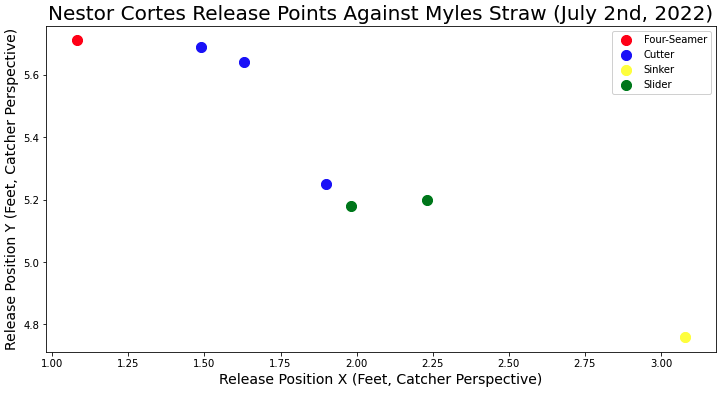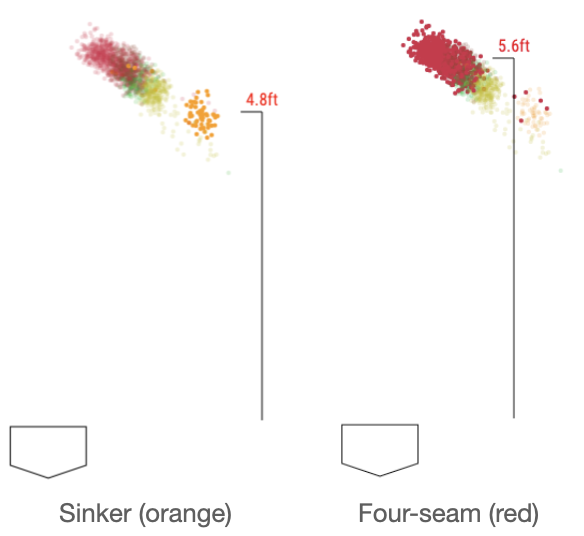How Effective Is Nestor Cortes’ Change of Arm Slot?

It’s hard to watch a Nestor Cortes start without hearing the broadcasters mention his varied delivery. Baseball savant would agree, writing that his release points “tend() to [be]…very erratic”. I’m not writing about the effectiveness of altered arm slots or release points on a larger scale. Ben Palmer already did that over at PitcherList. I’ll instead simply write about Cortes and the outcomes he has produced with varied release points. If you want a deep dive on Cortes, look no further than Nicklaus Gaut’s fine piece early in the season.
Let’s jump right into an at-bat. Here we see Myles Straw facing Nestor Cortes on a 2-2 count:
–
That’s a simple cutter with not much deception or deviation from a normal delivery. But, Cortes still has a pitch to spare and he adds in a little shake-up with this 2-2 sinker:
–
Cortes comes at Myles Straw with the ol’ side sweep. Did it force Straw into a swing? Perhaps it created a little moment of inner thought from Straw like, “Ah…what’s that?..Uh..SWING!”. Or, did Straw simply see the change of slot and read the pitch as he would any other? Neither Cortes nor Straw really won this single-pitch battle and the count remained even. So, what did Cortes follow up with? Another 2-2 cutter:
–
How different was the release point of that funky sinker from all the other pitches in that at-bat? Here are all the release points from that specific at-bat against Straw in the bottom of the third:

That sinker is relatively far off when compared to the other pitches Cortes has thrown. So, how about that one sinker compared to other sinkers he threw during his July 2nd start against the Guardians? Well, he only threw three in total, but they are significantly different:

Ok, “significantly different” is probably debatable. The small scale of this visualization creates a bit of deception in itself. Here are links to the other two sinkers if you’d like to make comparisons:
You will likely notice that Cortes’ sinker almost always comes from that side-arm angle. He’s not necessarily dropping down with a four-seamer to throw batters off. No, he’s using that delivery for sinkers. So, are hitters picking up on that more? Well, it may be hard to come to any conclusions given the small sample of pitches in the past two years and it depends on what metric you’re analyzing. But, from a BA/SLG/wOBA perspective, the pitch has remained difficult to put into play. Batters are coming up empty against the pitch more often, but it’s getting hit harder in 2022:
| Pitches | BA | SLG | wOBA | Whiff% | K% | HardHit% | |
|---|---|---|---|---|---|---|---|
| 2022 | 46 | 0.077 | 0.077 | 0.069 | 37.5 | 76.9 | 66.7 |
| 2021 | 62 | 0.000 | 0.000 | 0.033 | 28.6 | 57.1 | 50.0 |
It’s nice to isolate Cortes’ sinker and view its performance from a few different metrics, but doing so doesn’t allow us to see if the release point has anything to do with its effectiveness. Cortes only throws the sinker about 3% of the time. Its average velocity is the same as his four-seamer and it’s vertical/horizontal movement measurements are not going to jump off the page. Yet, the delivery of the pitch is what makes it unique. In 2022 Cortes has been throwing the sinker almost completely from that side release point. Is it intentionally being thrown to keep batters off rhythm?

Source: Baseball Savant
If you look closely enough, you can see that there are just a few sinkers mixed in where the four-seamers usually are and vice-versa. When I first saw these images next to each other it appeared to me that Cortes has released a few sinkers with a four-seam delivery and a few four-seamers with a sinker delivery. I thought, “Wow! That’s some deception!” However, I think those orange (sinker) dots mixed into the red (four-seamer) dots are really just misclassified pitches. Here are two examples:
Possible misclassified sinker #1
Possible misclassified sinker #2
They sure look like four-seam fastballs to me, and since the two pitches have very similar average velocities, they’re probably difficult for a computer to differentiate. So, let’s just say they are misclassifications and that Cortes throws sinkers off to the side and four-seamers closer to his body. What now? Well, we have two somewhat similar pitches, one of them is released more over the top and the other is released more to the side and the question remains, is that variation effective? The best way I can think to measure this is to compare sinkers that were thrown directly after four-seamers and compare them to all sinkers. My thinking here is that if a batter has seen a fastball, more over the top, and then sees a sinker, more off to the side, is that better? Does that work? Let’s see:
| Test | Control | |
|---|---|---|
| Pitches | 18 | 47 |
| Called Ball% | 56% | 53% |
| SwStr% | 5% | 8% |
| CStr% | 11% | 13% |
| CSW% | 17% | 26% |
| AVG | 0.000 | 0.021 |
There are many ways to measure this. Maybe you have some ideas of your own. Do share. The best I could come up with is breaking sinkers down into control and experimental groups. In this case, the control group represents all sinkers and the test group represents all sinkers that come directly after a four-seamer. The samples are too small to make any claims of statistical significance, but we can see that the control group is performing slightly better by SwStr%, CStr%, and CSW%. The test group hasn’t given up a hit yet, but what’s most interesting is that it produces more takes for balls. This is interesting in that when a batter sees that arm slot change, they may just lay off because they’re thrown off and would rather not swing. Does that mean Cortes should just try slinging a sinker into the heart of the zone because he knows hitters will be surprised and lay off? Maybe. I think in the grand scheme of things, there’s not much to wrap our fingers around here besides that.
I’ve always wondered if deception is worth the effort and this article was an attempt at measuring/testing that wonder. That’s really what it’s all about, isn’t it? Curiosity? It actually just seems that this is the way he throws his sinker. That could become an issue if hitters pick up on it, know a sinker is coming, and start mashing. But “mashing” isn’t usually a word you use in the same sentence as, “sinker”. I know that if I was ramped up for a fastball and suddenly I got the ol’ side sweep arm angle, I would hesitate on the swing. That could work to Cortes’ benefit. If that’s the case, he should throw a side sweep sinker right down the middle because he knows he’ll get a take. But, he should take caution, because if hitters pick up on that, and they will pick up on that, they could start seeing that arm angle and lick their lips. Luckily for Cortes, it’s a sinker that is hard to square up. There’s room here for further analysis, or there’s room here to simply sit back and keep an eye out for the altered delivery. $5 says the broadcasters will point it out too.

It seems like the rarity of the pitch plus the quick delivery makes it a bit surprising for batters and hard to anticipate. Cortes certainly seems like a pitcher who uses guile, timing, and varied arm slots to complement his arsenal and make himself more difficult to hit against – so far pretty successfully.
I appreciate the effort with the “test,” but it’s hard to say that batters take more balls on sinkers following a four-seamer when each ball taken is 5.6% and the difference between “groups” is just 3%. It seems Cortes’ infrequent usage of the pitch is making it just as hard for analysts as it is (or might be anyway) for hitters.